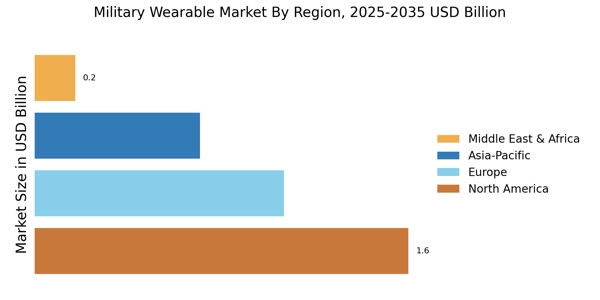Integration of Artificial Intelligence
The integration of artificial intelligence (AI) into the Military Wearable Market is transforming how military personnel operate in the field. AI enhances decision-making processes by analyzing vast amounts of data in real-time, which can lead to improved situational awareness and operational efficiency. For instance, AI-driven wearables can monitor soldiers' health metrics and predict potential health issues before they escalate. This capability is particularly crucial in high-stress environments where timely interventions can save lives. The market for ai in military wearables is projected to grow significantly, with estimates suggesting a compound annual growth rate of over 15% in the coming years. As militaries increasingly adopt AI technologies, the Military Wearable Market is likely to see a surge in demand for innovative solutions that enhance soldier performance and safety.
Rising Demand for Enhanced Soldier Safety
The rising demand for enhanced soldier safety is a pivotal driver in the Military Wearable Market. As military operations become more complex and dangerous, the need for advanced wearable technologies that can provide real-time data on environmental hazards, health status, and location is paramount. Wearables equipped with sensors can detect chemical, biological, and radiological threats, thereby ensuring that soldiers are better prepared for various combat scenarios. According to recent estimates, the market for safety-focused military wearables is expected to reach several billion dollars by 2027, reflecting a growing recognition of the importance of soldier protection. This trend indicates that defense budgets are increasingly allocating resources towards innovative wearable technologies that prioritize the safety and well-being of military personnel.
Advancements in Communication Technologies
Advancements in communication technologies are significantly influencing the Military Wearable Market. Enhanced communication capabilities allow soldiers to maintain connectivity in challenging environments, which is essential for mission success. Wearable devices that integrate secure communication systems enable real-time information sharing among troops, improving coordination and response times during operations. The market for communication-focused military wearables is projected to expand, with estimates indicating a growth rate of approximately 12% annually. This growth is driven by the increasing need for reliable communication tools that can function in diverse operational theaters. As militaries invest in next-generation communication technologies, the Military Wearable Market is likely to evolve, offering innovative solutions that enhance operational effectiveness and soldier collaboration.
Increased Investment in Defense Technology
Increased investment in defense technology is a crucial driver of the Military Wearable Market. Governments worldwide are recognizing the need to modernize their armed forces, leading to substantial funding for advanced military technologies, including wearables. This investment is often aimed at enhancing operational capabilities, soldier safety, and overall mission effectiveness. Recent reports indicate that defense budgets are projected to grow, with a significant portion allocated to research and development of innovative wearable technologies. As nations prioritize modernization efforts, the Military Wearable Market is likely to benefit from increased funding and support for cutting-edge solutions that address the evolving needs of military personnel. This trend suggests a robust future for the market as defense agencies seek to leverage technology to maintain a strategic advantage.
Focus on Data Analytics and Performance Monitoring
The focus on data analytics and performance monitoring is reshaping the Military Wearable Market. Wearable devices that collect and analyze data on soldiers' physical and mental performance are becoming increasingly prevalent. These devices can track vital signs, fatigue levels, and stress indicators, providing commanders with valuable insights into troop readiness and well-being. The market for performance monitoring wearables is expected to grow, with projections suggesting a rise in demand for analytics-driven solutions that enhance operational efficiency. By leveraging data analytics, military organizations can make informed decisions regarding training, resource allocation, and health interventions. This trend underscores the importance of integrating advanced analytics into military wearables, ultimately contributing to improved soldier performance and mission outcomes.

















